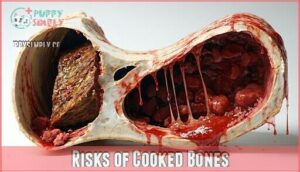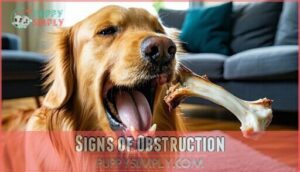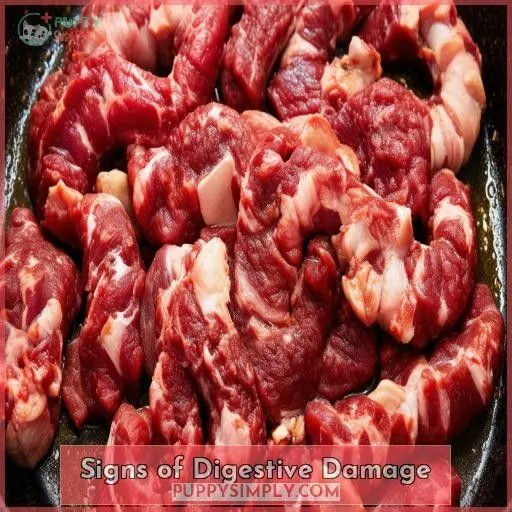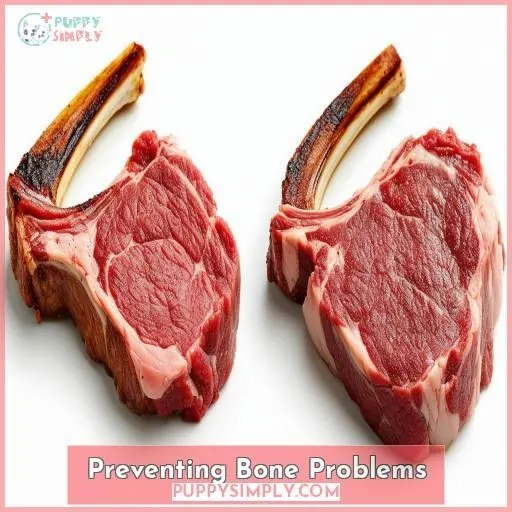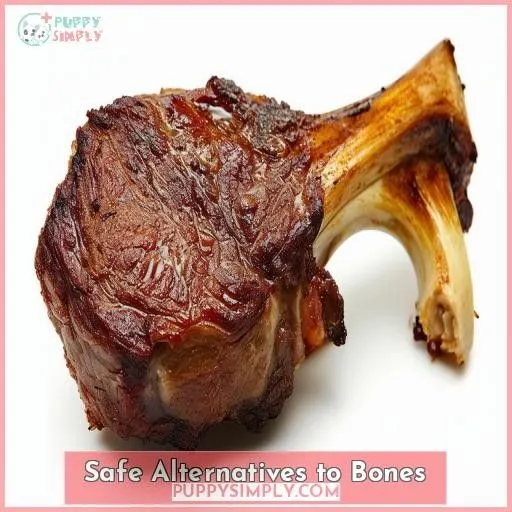This site is supported by our readers. We may earn a commission, at no cost to you, if you purchase through links.
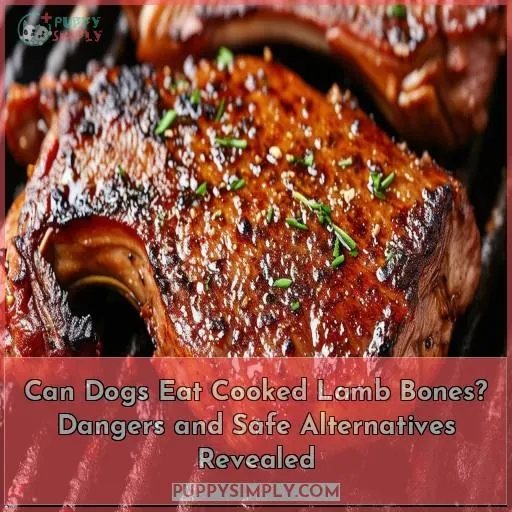 You shouldn’t feed your dog cooked lamb bones. They splinter easily, posing serious risks like puncturing the digestive tract or causing obstructions.
You shouldn’t feed your dog cooked lamb bones. They splinter easily, posing serious risks like puncturing the digestive tract or causing obstructions.
Watch for signs of trouble like vomiting, lethargy, or difficulty swallowing. Prevent bone-related emergencies by always supervising your pup, using muzzles if needed, and seeking vet care promptly.
Instead, satisfy their urge to chew with safe alternatives like dental treats or food puzzles. Trust me, you’ll sleep better knowing your furry friend isn’t at risk from cooked lamb bones.
Want to avoid nasty vet bills and heartache? Keep reading for more safe chewing tips.
Table Of Contents
- Key Takeaways
- Can Dogs Eat Cooked Lamb Bones?
- Risks of Cooked Bones
- Signs of Obstruction
- Signs of Digestive Damage
- Preventing Bone Problems
- Safe Alternatives to Bones
- Frequently Asked Questions (FAQs)
- Is it okay to give a dog a cooked lamb bone?
- What cooked bones can dogs eat?
- Should lamb be cooked for dogs?
- Can dogs eat lamb feet?
- How long should bones be avoided after splinter ingestion?
- Are there any breeds more prone to bone problems?
- Can lamb bones cause pancreatitis in dogs?
- What are safe chew toys for aggressive chewers?
- Do puppy and senior dogs require different precautions?
- Conclusion
Key Takeaways
- Cooked lamb bones are like tiny daggers ready to wreak havoc on your pup’s insides. One wrong gulp, and you’re in for a world of hurt (and vet bills!). Not worth the risk, if you ask me.
- If your dog is acting off after munching on those bones – coughing, drooling, lack of appetite – it’s a giant red flag waving. Don’t ignore those signs of internal mayhem, or you might have a real mess on your hands.
- While that momentary chewing bliss might seem harmless, cooked bones turn into jagged shrapnel just waiting to puncture their delicate plumbing. Why take that gamble when safer chew toy options exist?
- Prevent bone-related emergencies by keeping a hawk-eye on your furry companion during chew time. And for the love of dog, ditch the cooked bones – that potential for obstruction and bleeding just isn’t worth it. Let them gnaw on some durable rubber or antler chews instead.
Can Dogs Eat Cooked Lamb Bones?
No, dogs shouldn’t eat cooked lamb bones. Cooked bones can splinter and cause choking, obstruction, or puncture the digestive tract, which can be life-threatening.
Risks of Cooked Bones
Cooked lamb bones might seem like a tasty treat, but they pose serious risks for your furry friend.
As bones cook, they become porous and brittle, splintering into jagged shards that can puncture your pup’s digestive tract.
Those shards act like tiny knives, potentially causing internal bleeding, a sore abdomen, and even obstructions requiring surgery.
While dogs gnaw, they also ingest those bone fragments and marrow, which can wreak havoc on their system.
Skip the cooked bones – that momentary enjoyment isn’t worth risking your dog’s wellbeing.
Stick to safer chew toys instead.
Signs of Obstruction
If your dog is coughing or choking excessively after eating cooked lamb bones, it could indicate an obstruction in their throat or airway. Watch for signs like excessive drooling or difficulty swallowing, as these may signal that a bone splinter or piece is stuck and requires immediate veterinary attention.
Choking/Coughing
You may notice your dog coughing or choking after eating cooked lamb bones. This signals:
- Bone splinters stuck in throat
- Airway obstruction risk
- Need to clear airway immediately
- Potential for further complications
Excessive Salivation
If your dog is excessively drooling after eating cooked lamb bones, it could indicate an obstruction or dental issue. Carefully check for any mouth or throat injuries.
Difficulty Eating
If your pup is having difficulty eating or coughing up blood, it could indicate bone splinters are obstructing their airway or digestive tract. Seek veterinary care immediately if these alarming symptoms occur.
Signs of Digestive Damage
If your dog isn’t eating after consuming cooked lamb bones, it’s a major red flag indicating digestive damage. Lethargy and vomiting are additional warning signs that the bones have irritated or obstructed your dog’s digestive tract, requiring prompt veterinary attention.
Loss of Appetite
If your pup loses its appetite after gobbling cooked lamb bones, it’s a telltale sign of GI distress. Don’t ignore this red flag – digestive damage can swiftly escalate.
Lethargy
Lethargy often accompanies gastrointestinal issues from cooked bones. If your dog seems lethargic after eating lamb bones, it’s likely due to nausea from GI irritation – a sign their body is struggling with the bone fragments. Stick to safe alternatives until they recover.
Vomiting
If your dog vomits after eating cooked lamb bones, it’s a clear sign of digestive distress. Nausea and vomiting can be triggered by the bone splinters irritating their stomach lining. Switching to a bland, easily digestible diet temporarily can help ease this issue.
Preventing Bone Problems
You must closely supervise your dog when they’re around bones to prevent potential problems. If your dog is determined to chew on bones, use a muzzle or seek alternative chew toys recommended by your veterinarian.
Supervise Dogs
Always supervise your dog when giving bones. Monitor duration, location, interactions, reactions, and environment. Make sure bones remain edible, chewable, large, and not swallowable. Supervising dogs during puppy training is wise.
Use Muzzles
When dogs can’t resist temptation, use a properly fitted muzzle. It provides:
- Physical barrier to ingestion
- Training opportunity
- Peace of mind
Never underestimate a determined pup’s resourcefulness. Muzzles promote safety for dogs and owners alike when introducing new chew toys or during pet sitting visits.
Seek Vet Care
If your dog eats cooked bones, contact your vet immediately for guidance. Home remedies may worsen the situation, especially for small breeds and seniors. Prevention is key – keeping bones away avoids emergencies altogether.
| Risks | Symptoms | Actions |
|---|---|---|
| Choking | Gagging, pawing mouth | Heimlich, clear airway |
| Obstruction | Vomiting, lethargy | Vet visit, possible surgery |
| Laceration | Bleeding, pain | Gentle exam, vet care |
| Pancreatitis | Diarrhea, lack of appetite | Fluid therapy, medication |
Safe Alternatives to Bones
Instead of feeding your dog cooked lamb bones, which can splinter and cause blockages or lacerations, provide safe chew toys designed for heavy chewers. Dental treats help clean their teeth and satisfy the urge to chew, while food puzzles keep them mentally stimulated as they work for their meals.
Chew Toys
Consider chew toys for play time and teething – they satisfy a dog’s urge to chew while preventing dangerous situations. Durable rubber or nylon chews promote dental health and can be incorporated into reward training.
Dental Treats
Dental treats offer a safe, edible chew option that cleans your pup’s teeth as they gnaw: antlers, bully sticks, dental chews. Providing nutritional value and dental health benefits, these tasty alternatives prevent dangerous bone obstructions.
Food Puzzles
You can try food puzzles – devices designed to challenge your pup’s mind while dispensing treats. These enrichment toys prevent boredom, provide mental stimulation, and control calories safely.
Frequently Asked Questions (FAQs)
Is it okay to give a dog a cooked lamb bone?
No, you should never give your dog cooked lamb bones. Cooked bones can splinter and cause obstructions, perforations, or lacerations to the digestive tract, which is extremely dangerous.
What cooked bones can dogs eat?
You shouldn’t give your dog cooked bones of any kind – they’re brittle and can splinter, causing internal injuries or obstructions. Stick to raw, uncooked bones that are large enough not to be swallowed whole.
Should lamb be cooked for dogs?
A jaw-dropping NO! Cooked lamb bones splinter easily, causing severe internal injuries. For your pup’s safety, serve only raw, larger bones explicitly meant for chewing under vigilant supervision. Their well-being comes first – steer clear of cooked bones altogether.
Can dogs eat lamb feet?
No, you shouldn’t feed lamb feet to dogs. The small bones can splinter and cause obstructions or punctures in their digestive tract, leading to serious health issues. It’s best to avoid giving dogs any cooked bones as they can be brittle and pose risks.
How long should bones be avoided after splinter ingestion?
Imagine your pup gulping down a bone splinter. You’ll want to avoid any bones for at least 2-3 weeks to prevent further digestive issues. Play it safe – stick to treats specially made for dogs until their system is back to normal.
Are there any breeds more prone to bone problems?
Some breeds like greyhounds and whippets are more prone to swallowing bones whole due to their narrow jawlines. Always supervise your dog and avoid high-risk chews for these breeds.
Can lamb bones cause pancreatitis in dogs?
Yes, lamb bones can potentially cause pancreatitis in dogs. The high fat content in marrow can trigger this painful inflammation of the pancreas. It’s best to avoid giving your pup cooked bones to prevent any unnecessary health risks.
What are safe chew toys for aggressive chewers?
Aggressive chewers need durable chew toys like thick rubber, antler, or solid nylon bones. Rotate new toys monthly; supervise chewing. Avoid thin plastic, hooves, or cooked bones that splinter.
Do puppy and senior dogs require different precautions?
Yes, puppies and seniors require different precautions. Puppies’ mouths are delicate, so avoid hard chews. Seniors may have dental issues, so softer treats are better. Always supervise to prevent choking hazards.
Conclusion
Bones may seem like a dog’s dream treat, but cooked lamb bones pose severe risks that far outweigh any benefits.
Rather than gambling with your pup’s health, play it safe by satisfying their urge to chew with durable toys and treats designed for canine dental care.


